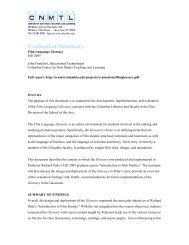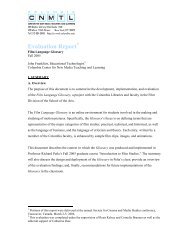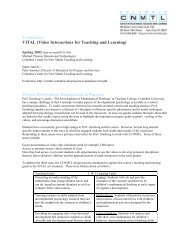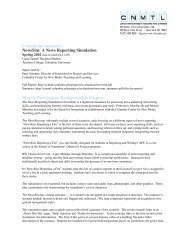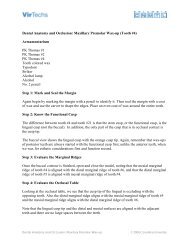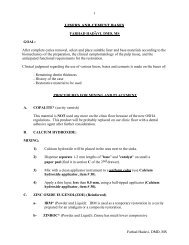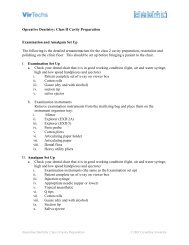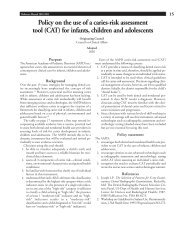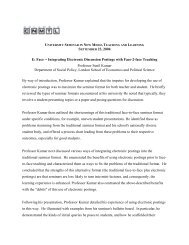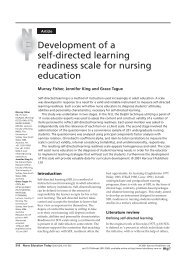Transcript for Stainless Steel Crown Restoration - Columbia University
Transcript for Stainless Steel Crown Restoration - Columbia University
Transcript for Stainless Steel Crown Restoration - Columbia University
You also want an ePaper? Increase the reach of your titles
YUMPU automatically turns print PDFs into web optimized ePapers that Google loves.
Pediatrics: <strong>Stainless</strong> <strong>Steel</strong> <strong>Crown</strong> <strong>Restoration</strong><br />
Armamentarium<br />
<strong>Crown</strong>-contouring pliers<br />
<strong>Crown</strong> crimping pliers<br />
Mirror<br />
Spatula<br />
Plastic instrument<br />
College pliers<br />
Perio-probe<br />
Large spoon excavator<br />
Heatless stone<br />
Burlew wheel<br />
Proper burs <strong>for</strong> this exercise,<br />
#245 and a #133f finishing stone<br />
<strong>Stainless</strong> steel crown<br />
Step 1: Introduction, Anesthesia, and <strong>Crown</strong> Selection<br />
Today's exercise is the stainless steel crown restoration. Indications have been discussed in class,<br />
so you just need to follow the guides. <strong>Stainless</strong> steel crowns are used in the full coverage<br />
restoration of both primary and young permanent teeth. The armamentarium <strong>for</strong> this laboratory<br />
exercise includes crown-contouring pliers, crown crimping pliers, mirror, spatula, plastic<br />
instrument, college pliers, perio-probe, large spoon excavator, heatless stone, Burlew wheel, and<br />
the proper burs <strong>for</strong> this exercise, #245 and a #133F finishing stone, and the stainless steel crown.<br />
Local anesthesia is normally required <strong>for</strong> this exercise. Some of these teeth will already have<br />
been pulpally treated or may need pulp therapy, but you will still be required to proniae soft<br />
tissue anesthesia <strong>for</strong> the stainless steel crown fabrication. In the event that it's pulpally treated,<br />
you can administer an infiltration or you may administer papillary infiltrations around the<br />
marginal gingiva. Whenever a rubber dam is required, anesthesia is also required. A rubber dam<br />
clamp should be placed on the tooth distal to the one you work on.<br />
Today's exercise involves the fabrication of a stainless steel crown on tooth letter K: the<br />
mandibular left second primary molar. A boley gauge or a perioprobe can be used to measure<br />
mesiodistal dimension. Our tooth measures about 10 millimeters. From the stainless steel crown<br />
kit - which provides an assortment of sizes <strong>for</strong> the mandibular left second primary molars - we<br />
select an appropriate crown that matches the 10 millimeter measurement that we took from the<br />
typodont tooth letter K. In our case a size 3 is an appropriate selection. In the event the tooth in<br />
question is grossly decayed, one should obtain crown dimensions from the corresponding tooth<br />
in the contralateral arch.<br />
Pediatrics: <strong>Stainless</strong> <strong>Steel</strong> <strong>Crown</strong> <strong>Restoration</strong> © 2006 <strong>Columbia</strong> <strong>University</strong>
Step 2: Occlusal Reduction<br />
Once anesthesia is achieved, we're ready to begin the exercise. We select a #245 tapered fissure<br />
bur. Using the #245 bur, we want to produce pilot cuts or guide cuts on the occlusal surface,<br />
establishing a 1 mm depth cut. Then you connect all of the guide cuts. Thus producing a uni<strong>for</strong>m,<br />
occlusal reduction. I did the buccal surface, and I do the same thing from the lingual surface. The<br />
end result is a uni<strong>for</strong>m reduction that mimics the shape of the original tooth.<br />
Step 3: Proximal Reduction<br />
Then switch the bur to a #133F diamond. What you want to do is to slice directly through the<br />
proximal surface. Starting from the buccal surface, you want to reduce or eliminate the contact<br />
without creating a ledge in the proximal space, and/or damaging the approximating tooth. Switch<br />
to the distal surface. Per<strong>for</strong>m the same procedure.<br />
Then you can use an explorer (in this case we are using a perioprobe). Slide through the proximal<br />
surface to ensure that you don't have contact.<br />
Step 4: Round Line Angles<br />
You look at the preparation so far and you notice that it is occlusally square. Notice that you've<br />
squared off the distal and the mesial proximal walls, and that all these line angles are sharp. If<br />
you study the internal detail of the crown, everything is rounded. Your preparation needs to<br />
reflect that roundness. So we go back to the preparation and round or bevel all line angles.<br />
Step 5: Seat <strong>Crown</strong>, Check Occlusion, and Score <strong>Crown</strong><br />
Next take the pre-selected stainless steel crown and seat the lingual surface first, and with firm<br />
finger pressure, seat the crown over the prepared tooth. The snap indicates it's rolling over a<br />
height of contour, which is what gives you the retention that we're looking <strong>for</strong>.<br />
We then check the occlusion and can see that we're almost in occlusion, but most significantly is<br />
the fact that the crown is too long. If we take an explorer and tease back the gingiva, we see the<br />
crown length is in excess of 1 mm subgingival. So next we'll shorten the crown length so that the<br />
crown will seat to a position where the gingival margin of the crown is 1 mm below the free<br />
gingival margin.<br />
First we score a thin line using a sharp spoon excavator resting on the free gingival margin. If<br />
you use an explorer to do this procedure the scratch mark will be too wide so use a sharp spoon<br />
excavator. Do the same thing on the lingual surface. Then use the spoon excavator to lift the<br />
crown off of the prepared tooth.<br />
Step 6: <strong>Crown</strong> Adjustment<br />
Now study the position of the scratch line. You can see that the scratch line is well below, greater<br />
than 1 mm, longer than the position of the scratch line. So this crown needs to be shortened.<br />
Pediatrics: <strong>Stainless</strong> <strong>Steel</strong> <strong>Crown</strong> <strong>Restoration</strong> Page 2 of 4
We use a heatless stone to shorten the crown. Hold the hand piece so that you can see where the<br />
scratch line is. With the heatless stone, we shorten the length of the crown. The proximal<br />
reduction is a line that connects the buccal line and lingual line and rises up in the proximal<br />
space.<br />
Inside the crown, the heatless stone leaves a bur that can only be removed with a spoon<br />
excavator. So you just scrape the bur out. Remove the residual stainless steel that is <strong>for</strong>ced<br />
internal of the crown.<br />
Go back to the typodont <strong>for</strong> another seating, and a second scoring of the height of the free<br />
gingiva. You want to repeat this until you reach a point where the line doesn't change. Continue<br />
with the shortening of the margins. And repeat the removal of the bur using a large spoon<br />
excavator.<br />
Return to the preparation and reseat. Position it back in the typodont and check the occlusion.<br />
Test the occlusion with articulating paper. The crown is in occlusion. Gingival length is 1mm<br />
below the free gingival margin.<br />
Step 7: <strong>Crown</strong> Adaptation<br />
Now we test the adaptation by taking the tine end of an explorer and feeling below the free<br />
gingival margin to determine if there are any open margins. We do this buccally, lingually and<br />
proximally. Note that you should not be able to lift the crown with the explorer. Since I can, it<br />
means our marginal fit is not tight enough. Marginal adaptation over height of contour provides<br />
retention, not cement.<br />
Go back to the spoon excavator and lift the crown off. We want to use the contouring plier to<br />
contour the gingival third of the stainless steel crown. Place the rounded end inside and in an<br />
overlapping fashion, go around the margin of the crown, squeezing the contouring plier. We<br />
have contoured the gingival third and now we're going to crimp the margins to tighten the<br />
stainless steel. This final adaptation will snap the margins over all height of contours. Using a<br />
139 plier, turn it so that the rounded end fits inside the crown. Using the crimping plier, crimp<br />
the margin all the way around, in overlapping crimps. About the last 2 mm of the length of the<br />
crown is where you're crimping.<br />
Go back to the typodont and in a lingual to buccal roll with firm finger pressure you reseat the<br />
crown. Although we hear a snap, the adaptation still requires some adjustment. We're going to<br />
lift it and crimp it again. Then go back to the typodont to reseat the crown and you can hear the<br />
snap fit. Check the occlusion. So now we have a crown that is nearly complete and in occlusion.<br />
Marginal adaptation has been done. It fits to a point 1mm below the gingival margin.<br />
Pediatrics: <strong>Stainless</strong> <strong>Steel</strong> <strong>Crown</strong> <strong>Restoration</strong> Page 3 of 4
Step 8: Finishing and Polishing<br />
The only thing left to do is to finish and polish and then cement. Lift the crown off again. What<br />
we've done in shortening the length of the crown is to remove the knife-edge finish that it had.<br />
You can see that there's a blunt margin where the stainless steel crown adapts to the tooth. What<br />
we need to do is to take the heatless stone again and using an angle, recreate the knife-edge in the<br />
last 1 mm of the crown. We're not shortening it, just re-creating a knife-edge finish to the<br />
margin.<br />
Remove the heatless stone, switch to a burlew wheel and repeat the same thing, creating a<br />
smooth polished finish. It removes the scratches and polishes the bevel.<br />
Step 9: Cementation<br />
Now we are prepared <strong>for</strong> cementation. We have our crown ready to go and a dry isolated field.<br />
Cementation of the crown is achieved by using a glass ionomer like Ketac cement. It is important<br />
to follow manufacturer's mixing instruction and to work fast as the cement sets fairly rapidly.<br />
You want a luting consistency of cement and this material is going to start setting as soon as you<br />
finish spatulating. So you want to have everything prepared. The rubber dam may be removed at<br />
this point and cotton roll isolation is achieved. Use an adequate amount of cement just enough to<br />
fill up the crown.<br />
Step 10: Check Occlusion and Finish<br />
Have the patient bite the crown into occlusion. Do not use a bite stick or a cotton roll. Biting on a<br />
roll or bite stick is going to create hypo-occlusion and over-seat the crown. When the cement<br />
reaches a gelled state you begin a removal of the excess material proximally and subgingivially.<br />
This may be achieved with a carving instrument and dental floss. Floss the interproximal areas to<br />
remove excess cement. Please remember that time is of essence as the cement sets rapidly.<br />
Case completed.<br />
Pediatrics: <strong>Stainless</strong> <strong>Steel</strong> <strong>Crown</strong> <strong>Restoration</strong> Page 4 of 4




